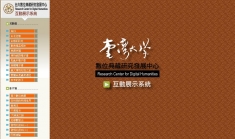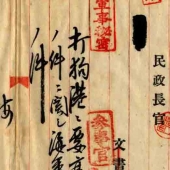|
Government-Owned Enterprises Digital Archives of Taiwan, National Archives Administration |
|
 Government-owned enterprises have been an important part of Taiwan’s industry. They were the corner stones in Taiwan’s economic development in the post-war period. Their growth reflected the operation and management of the companies, the relationship between manufacturing technology and industries, and the impact of national policies on the social and economic developments in Taiwan. Their history in the past six decades is documentary material for the historical and academic researches. .....
Government-owned enterprises have been an important part of Taiwan’s industry. They were the corner stones in Taiwan’s economic development in the post-war period. Their growth reflected the operation and management of the companies, the relationship between manufacturing technology and industries, and the impact of national policies on the social and economic developments in Taiwan. Their history in the past six decades is documentary material for the historical and academic researches. .....
|
|
Read more...
|
|
Digitizing the Past, Creating the Future---The Digital Archives Projects of National Taiwan University |
|
 National Taiwan University (NTU) is the oldest research institute devoted to diverse fieldworks and houses one of the most comprehensive records of natural and cultural history in Taiwan. Since 2002, NTU has initiated a digital project to archiving the research heritage in order to preserve and to broaden public access to the legacy holdings. It is a collaborative effort involving a wide variety of content and data types, reflective of the many research specialties in the university. We have created digital contents and databases, from anthropology to zoology, representing the rich cultural and biological diversity of Taiwan. .....
National Taiwan University (NTU) is the oldest research institute devoted to diverse fieldworks and houses one of the most comprehensive records of natural and cultural history in Taiwan. Since 2002, NTU has initiated a digital project to archiving the research heritage in order to preserve and to broaden public access to the legacy holdings. It is a collaborative effort involving a wide variety of content and data types, reflective of the many research specialties in the university. We have created digital contents and databases, from anthropology to zoology, representing the rich cultural and biological diversity of Taiwan. .....
|
|
Read more...
|
|
 Currently, there are many historical documents and artifacts that still hold much value for present society. These excerpts of history silently exist among us, but who will unearth these valuable messages? They are still dispersed over a wide area, but who will renew these artifacts? Since the Japanese colonial period, National Taiwan University, then Taihoku Imperial University, started to collect and preserve precious documents and artifacts pertaining to Taiwanese culture. .....
Currently, there are many historical documents and artifacts that still hold much value for present society. These excerpts of history silently exist among us, but who will unearth these valuable messages? They are still dispersed over a wide area, but who will renew these artifacts? Since the Japanese colonial period, National Taiwan University, then Taihoku Imperial University, started to collect and preserve precious documents and artifacts pertaining to Taiwanese culture. .....
|
|
Read more...
|
|
 Under the supervision of Liu Mingchuan, then Governor of Taiwan, the construction of the railroad connecting Taipei and Keelung started in 1887, and by 1893, the rail line had reached Hsinchu. After a change of regime, in 1895 the Japanese colonial government started laying tracks to cover cities south of Hsinchu. In 1908, the North-South Line that stretches from Keelung to Kaohsiung was open for operation. Later construction and renovation extended the routes to Yilan, Hualien, Taitung, and Western areas. In addition to national railways, light rails (nicknamed Tai-train) laid by ......
Under the supervision of Liu Mingchuan, then Governor of Taiwan, the construction of the railroad connecting Taipei and Keelung started in 1887, and by 1893, the rail line had reached Hsinchu. After a change of regime, in 1895 the Japanese colonial government started laying tracks to cover cities south of Hsinchu. In 1908, the North-South Line that stretches from Keelung to Kaohsiung was open for operation. Later construction and renovation extended the routes to Yilan, Hualien, Taitung, and Western areas. In addition to national railways, light rails (nicknamed Tai-train) laid by ......
|
|
Read more...
|
|
 Formerly named Takau Port, the Port of Kaohsiung is the most important commercial harbor in southern Taiwan. Early into the Japanese rule, there were already deliberations on constructing a modern harbor on the site of Takau Port, since the original port suffered from shallow drafts, high reefs, and a lagoon at its perimeter. The construction project started in 1908 on a budget of 4,735,000 yuan; however, after going through several revisions and expansion ......
Formerly named Takau Port, the Port of Kaohsiung is the most important commercial harbor in southern Taiwan. Early into the Japanese rule, there were already deliberations on constructing a modern harbor on the site of Takau Port, since the original port suffered from shallow drafts, high reefs, and a lagoon at its perimeter. The construction project started in 1908 on a budget of 4,735,000 yuan; however, after going through several revisions and expansion ......
|
|
Read more...
|
|
|
 Shinto is the religion native to Japan and Shinto shrines are sacred places where deities in the religion are enshrined. Traditionally, Shinto shrines are located in or surrounded by tranquil and lush forests to create a solemn and sacred atmosphere for the worshippers. The shrine culture was brought to Taiwan during the Japanese colonial period, and in 1897, the first shrine, Kaizan Shrine, was built in Tainan (figure1). Of all the Shinto shrines around the island, the most notable one is the Taiwan Shrine, where the Palace ......
Shinto is the religion native to Japan and Shinto shrines are sacred places where deities in the religion are enshrined. Traditionally, Shinto shrines are located in or surrounded by tranquil and lush forests to create a solemn and sacred atmosphere for the worshippers. The shrine culture was brought to Taiwan during the Japanese colonial period, and in 1897, the first shrine, Kaizan Shrine, was built in Tainan (figure1). Of all the Shinto shrines around the island, the most notable one is the Taiwan Shrine, where the Palace ......
|
|
Read more...
|
|
|
<< Start < Prev 1 2 3 4 5 6 7 8 9 10 Next > End >>
|
|
Page 7 of 12 |